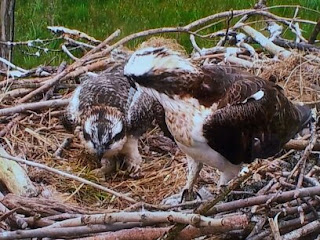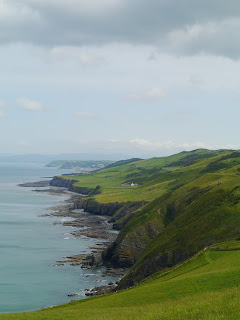Around the edge of
Wales (21) … Aberystwyth to
Penrhyndeudraeth
Another ‘mixed- mode’ section that combined good walking and
superb cycling. The journey took in some amazing sights, and perhaps provided my
overall favourite view of the whole holiday.
This leg started with an easy walk from Aberystwyth, over
the cliffs to caravan city at Clarach and then on to Borth, where I swapped for
a bike to round the estuary to Machynlleth and on through Meirionnydd. I’d left my full size bike in Pembrokeshire
so this was an ideal opportunity to test the folding Airnimal ‘Joey explore’
bike that I’d purchased some time ago but hadn’t had a chance to use. The
weather was fine, but there wasn’t a
single walker to be seen until I got to the monument at Borth cliffs.
I hadn’t wandered the cliffs beyond Clarach before, despite
living in Aberystwyth for three years. The cliffs are dark grey, shaly and very
friable along this section. There was a scary moment or two when Macsen the dog
hopped over the edge of the cliff to land on a slumped shelf of loose material below
- and then found the rocks too friable
to clamber back up. I had to coax her
along the cliff face, just hoping she’d keep her footing on the narrow,
semi-level sections, until I could reach over the edge and help haul her upwards
by the scruff of her neck. We just about managed it, whilst clumps of trefoil
topped shale fell away underneath my arm as I leant over and as the
dog scrambled madly over cascading shale. She was back on the lead for a long
time after this near-miss episode.
Yet another red kite, accompanied by another couple of
chough were again seen on the first headland
out of Clarach as I headed north, past a lovely and quite stately
looking house perched above a well preserved lime kiln. Was the location, close
to an eroding coastline, the reason for its rather sad and abandoned feel? The sea defence in front of it was rapidly
decaying – its days clearly numbered
.
Not the most interesting section, in terms of wildlife,
between Clarach and Borth. But the view of Cors Fochno (Borth Bog), behind the vast
beach, and with the view of the mountains behind, is staggeringly beautiful. At
the edge of the bog a solitary church stood out on a small hummock of land
between the village and the rusty expanse behind – as if to underline its
importance in this coastal, way-below-sea-level settlement. As I approached the village I fell alongside
a quartet of local tourism provider who were bemoaning the fact that Borth was
short of sand. Why couldn’t they import sand as they do in Tenerife? And what
was to be done about the prehistoric forest that was exposed at low tide? The
stumps were covered with slippery slime and there was going to be a string of
accidents this summer – they really should be removed in order to avert a
tragedy for the local tourist industry.
I scanned the beach, seeing miles of golden brown sand stretching out towards the mouth of the Dyfi estuary, and was looking forward to catching a glimpse of the sunken forest at low tide. I moved quickly onwards and opted to walk through Borth village, which I found to be far more attractive than I ever thought or remembered. The northern part of Borth beach was largely empty and I spent ages taking photos of various features and fiddling with camera settings. I turned inland at Ynyslas, following the coast path signs, though I would have stayed longer on the beach and turned east much further on had I known the path was only skirting the edge of the dune and the adjacent golf course. From here, the Borth boatyard looked bizzare, as if hulls and masts were rising out of the bog!
I had to get to the edge of the estuary to catch a glimpse
of the whole length of the estuary at low tide. Aberdyfi looked beautiful
across the sliver of water. Windscreens glinted along the edge of the dunes and
the odd car arrived to perform a few wheelies on the compacted sand – cheap
entertainment at the £1-a-go parking charge (surely far too low a fee for the
ability to spend a whole day in an amazing landscape and a special National
Nature Reserve?).
The ride to Machynlleth was quiet and relaxing, along flat
terrain with virtually no traffic until I got to the main road, through
Llancynfelyn. The traffic lights on the main Aberystwyth-Machynlleth road provided
an opportunity to admire the walling work being undertaken as part of the road
straightening and widening works on the Dyfi bends. The ride also took me past
the Montgomeryshire Wildlife Trust reserve at Cors Dyfi – where removal of a
conifer plantation some years ago has resulted in the restoration of estuarine
marsh habitat and where the appearance of nesting osprey in recent years has
created an interesting roadside visitor attraction and a focus for some great
wildlife volunteering work.
I stopped for some refreshment as soon as I got
into Aberdyfi and took a walk along the row of harbour terrace houses, each
with its tiny but enviable sea-edge garden and explored the coast around the
corner, where a stepped path has been hewn into the grey rock that is layered finely
like filo pastry.
Broadwater, from the Rhoslefain road, seemed to be a huge expanse of silver water, locked behind the seafront. Tonfannau was quiet, and strangely enough someone appeared to be living in the old military camp, with sheets and pillowcases billowing n a line outside one of the brick cabins.
I stopped at Llwyngwril to search for the Quakers graveyard
and eventually found it – a sweet place perched above the sea, with a tiny
gated entrance. I was surprised how few graves were visible in the western part of the
graveyard that had been allocated for Quaker burials when the site was taken
over by Wesleyan Methodists and wondered why this was the case.
On to Fairbourne , over the lovely flatlands of Mawddach marsh, to cross the estuary to Barmouth . There were plenty of people walking over the old railway bridge at this end-of-afternoon hour, along with a few fishermen, but no other cyclists. Mawddach estuary, along with the Dyfi and the Dwyryd estuaries must be some of the lovelies coastal views in the world – and the train ride between Machynlleth and Pwllheli has to be one of the best ways to see them all in one lazy, fell swoop.
Barmouth isn’t the
loveliest of towns. Many of the local stone houses look dark, dour and rather
forbidding. But I enjoyed the ride along the promenade and came across the
local ‘rheinws’ or lock up - divided to
house both males and females as the town
had a reputation for rough women back in the 18th-19th centuries.
The cycling was easy along this north Meirionnydd section with the road quiet
and the pavement providing an alternative cycle track. I stopped in Dyffryn Ardudwy to have a look at the amazing
chambered tomb behind the primary school. The evening was warm and the sun was
beginning to sink in a haze of orange and pink above the low coastal fields and
old airforce site below the coast road. I stopped in the pub at Llanbedr for a
swift half pint and chatted for a while to a lovely couple from Kent who were
visiting the area for the first time. I was glad of the gift of an extra packet
of crisps – I reckoned I’d need it before the evening was out. At Llanfair I
decided to turn inland to follow the Ardudwy way to Llandecwyn (Sustrans’ route 8). A decision I’ll never
regret. I think this was the best cycle ride I’ve ever experienced in my life.
The sun blazed ever more strongly as it sank behind the darkening Llŷn
hills, but to the south, the slopes of
the Rhinog mountains were still warm and glowing in the dying rays . Such
a magical place. It was a temptation to
stay but I needed to press on especially as I had no lights on this bike
either. I careered down the hills towards
Bryn Bwbach, and out to the main road that leads to the toll bridge across the
Dwyryd estuary. The end of a perfect
day.




















































